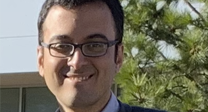Scientific Computing
Numerical simulation of real-world phenomena provides fertile ground for building interdisciplinary relationships. The SCI Institute has a long tradition of building these relationships in a win-win fashion – a win for the theoretical and algorithmic development of numerical modeling and simulation techniques and a win for the discipline-specific science of interest. High-order and adaptive methods, uncertainty quantification, complexity analysis, and parallelization are just some of the topics being investigated by SCI faculty. These areas of computing are being applied to a wide variety of engineering applications ranging from fluid mechanics and solid mechanics to bioelectricity.
Valerio Pascucci
Scientific Data Management
Chris Johnson
Problem Solving Environments
Ross Whitaker
GPUs
Chuck Hansen
GPUsFunded Research Projects:
Publications in Scientific Computing:
  Integrating Component-Based Scientific Computing Software S.G. Parker, K. Zhang, K. Damevski, C.R. Johnson. In Parallel Processing for Scientific Computing, Edited by M.A. Heroux and P. Raghavan and H.D. Simon, SIAM Press, pp. 271--288. 2006. ISBN: 0-89871-619-5 |
  Selecting the Numerical Flux in Discontinuous Galerkin Methods for Diffusion Problems R.M. Kirby, G.E. Karniadakis. In Journal of Scientific Computing, Vol. 22/23, pp. 385--411. 2005. |
  Visualization in the SCIRun Problem-Solving Environment D.M. Weinstein, S.G. Parker, J. Simpson, K. Zimmerman, G.M. Jones. In The Visualization Handbook, Edited by C.D. Hansen and C.R. Johnson, Elsevier, pp. 615--632. 2005. ISBN: 0-12-387582-X |
  Parallelization and Scalability of a Spectral Element Solver SCI Institute Technical Report, C.W. Hamman, R.M. Kirby, M. Berzins. No. UUSCI-2005-011, University of Utah, 2005. |
  Dynamic Response of Various Von-Karman Non-Linear Plate Models and their 3-D Counterparts Z. Yosibash, R.M. Kirby. In International Journal of Solids and Structures, Vol. 42, pp. 2517--2531. 2005. |
  Computational Simulation of Penetrating Trauma in Biological Soft Tissues Using the Material Point Method I. Ionescu, J. Guilkey, M. Berzins, R.M. Kirby, J.A. Weiss. In Proceedings, Medicine Meets Virtual Reality, Vol. 13, Edited by James D Westwood et al., IOS Press, pp. 213--218. 2005. ISBN: 1-58603-498-7 |
  Display of Vector Fields Using a Reaction Diffusion Model A.R. Sanderson, C.R. Johnson, R.M. Kirby. In Proceeding of IEEE Visualization 2004, pp. 115--122. 2004. |







